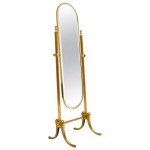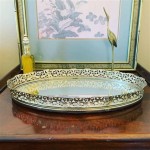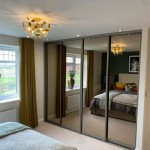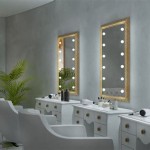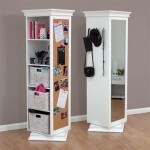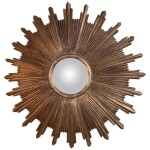How to Add a Wood Frame to a Bathroom Mirror
Adding a wood frame to a bathroom mirror is a straightforward project that can significantly enhance the aesthetic appeal of a bathroom. This process elevates a standard, builder-grade mirror to a custom, stylish focal point. This article provides a detailed guide to framing a bathroom mirror with wood.
Planning and Preparation
Careful planning is crucial for a successful outcome. Begin by accurately measuring the mirror's dimensions. These measurements determine the lumber requirements and guide the building process. Select a wood type suitable for bathroom conditions. Popular choices include cedar, redwood, and pine due to their moisture resistance. However, any wood can be used if properly sealed and finished. Consider the existing bathroom décor when choosing the wood type and frame style.
Material Acquisition
Once the measurements are taken and the wood type is selected, acquire the necessary materials. These typically include:
- Lumber: Purchase enough lumber to create the frame, accounting for miter cuts.
- Miter Saw: Essential for accurate angle cuts for a seamless frame.
- Wood Glue: Provides a strong bond between the frame pieces.
- Finishing Nails: Securely attach the frame pieces together.
- Wood Filler: Fills any nail holes or imperfections for a smooth finish.
- Sandpaper: Smooths the wood and prepares it for finishing.
- Wood Finish: Protects the wood from moisture and enhances its appearance. Options include paint, stain, and polyurethane.
- Measuring Tape: Ensures accurate measurements throughout the process.
- Safety Glasses: Protect eyes from wood debris and dust.
- Mirror Adhesive: A strong adhesive designed for adhering mirrors to surfaces.
Frame Construction
Cut the lumber into four pieces, ensuring the lengths correspond to the mirror's dimensions. A miter saw allows for precise 45-degree angle cuts, which create a professional-looking mitered joint. Apply wood glue to the mitered edges and join the pieces together, forming the frame. Secure the corners with finishing nails, countersinking them slightly below the wood surface.
Finishing the Frame
Fill any nail holes with wood filler and allow it to dry completely. Sand the entire frame, starting with a coarser grit sandpaper and progressing to a finer grit for a smooth surface. This prepares the wood for the finish and ensures a professional look. Apply the chosen wood finish according to the manufacturer's instructions. Multiple coats may be necessary for optimal protection and appearance. Allow sufficient drying time between each coat.
Attaching the Frame to the Mirror
Once the frame is completely dry, it's time to attach it to the mirror. Clean the mirror surface thoroughly to ensure proper adhesion. Apply mirror adhesive to the back of the frame, following the manufacturer's instructions. Carefully position the frame onto the mirror, ensuring it is centered and aligned. Apply even pressure to the frame to secure the bond. Use painter's tape or clamps to hold the frame in place while the adhesive dries completely.
Installation Considerations
Before installing the framed mirror, consider the existing wall conditions. Some walls might require additional support for the added weight of the framed mirror. If the original mirror was glued to the wall, carefully remove it to avoid damaging the wall. If the mirror was held in place with clips, these can often be reused with the new framed mirror. Consult a professional if uncertainties arise regarding wall conditions or installation methods.
Alternative Mounting Methods
While adhesive is a common method for attaching the frame, alternative methods exist. These include using clips specifically designed for framed mirrors, or creating a French cleat system for a more secure and removable mounting solution. The chosen method will depend on the weight of the framed mirror and the wall construction.
Maintenance and Care
Regular cleaning of the framed mirror helps maintain its appearance and prolong its lifespan. Use a non-abrasive cleaner and a soft cloth to avoid scratching the finish. Avoid excessive moisture, especially around the frame joints, to prevent water damage. Regular inspection of the frame and sealant can help identify any potential issues early on.
Customization Options
The design possibilities are vast when framing a bathroom mirror. Consider adding decorative molding to the frame for an intricate look. Experiment with different paint colors or staining techniques to achieve a unique finish. Incorporating elements like tile or mosaic into the frame can further personalize the design and complement the bathroom's overall aesthetic.

Mirror Frame Diy How To Update A Basic Bathroom Our Faux Farmhouse

Mirror Frame Diy How To Update A Basic Bathroom Our Faux Farmhouse

How To Frame A Mirror

Diy Stick On Mirror Frame Sawdust Sisters

How To Frame Out That Builder Basic Bathroom Mirror For 20 Or Less

Mirror Frame Diy How To Update A Basic Bathroom Our Faux Farmhouse

How To Frame Out That Builder Basic Bathroom Mirror For 20 Or Less

How To Add A Diy Wood Frame Bathroom Mirror Framed Mirrors Design

How To Frame A Bathroom Mirror For Just 10

How To Frame Out That Builder Basic Bathroom Mirror For 20 Or Less

